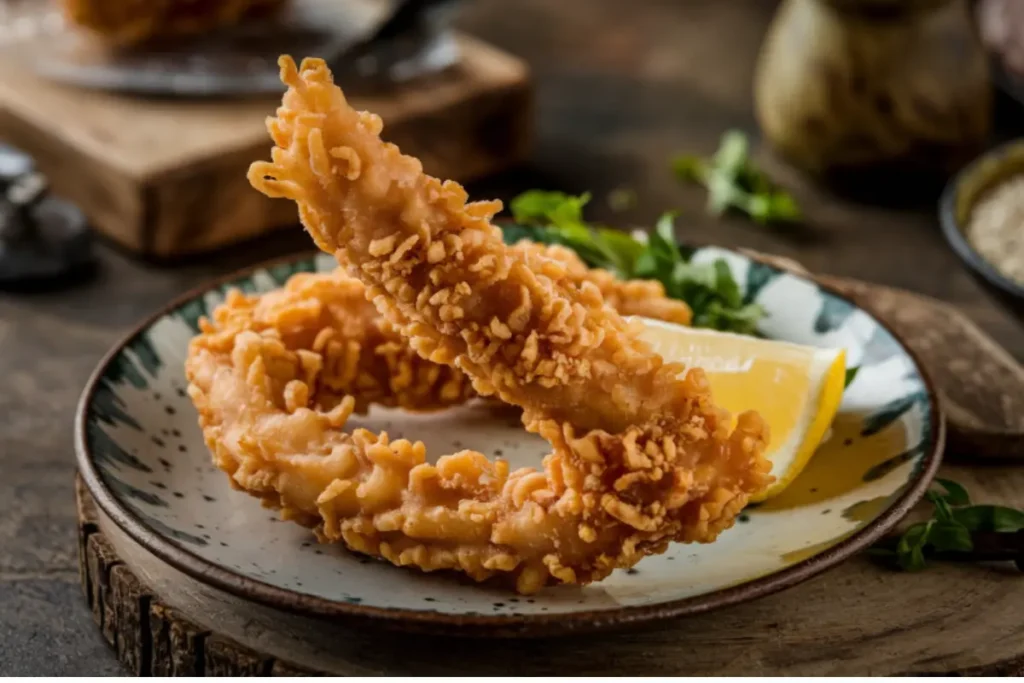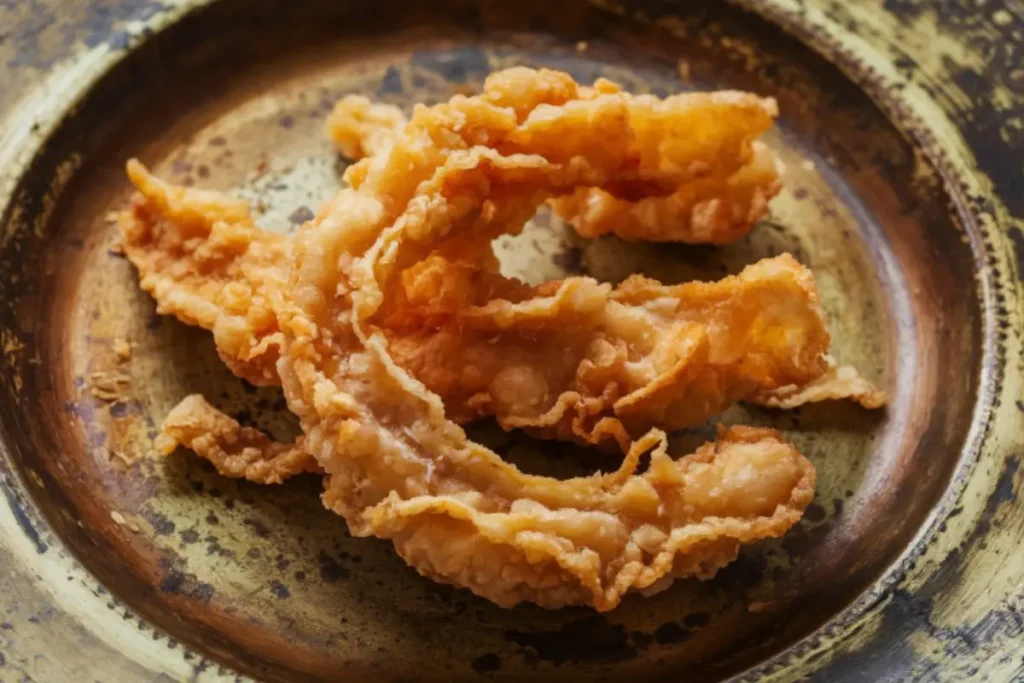Chicharrón is a dish that holds a special place in many cultures, especially in Latin America, Spain, and the Philippines. Known for its crispy texture and rich flavor, chicharrón is often enjoyed as a snack, a main dish, or an accompaniment to various meals. In this article, we’ll explore its history, variations, cultural significance, and how you can make it at home.
Part 1: Introduction
Chicharrón refers to a dish made from fried pork belly or fried pork rinds. The preparation method varies by region, but the result is always a crispy, savory delight that can be enjoyed on its own or as part of a larger dish. While pork is the most common meat used , variations made from chicken, beef, or fish also exist.
The popularity spans across continents, from the streets of Mexico to the kitchens of Spain and the Philippines. Each region has its own take on this dish, reflecting local tastes and traditions.
Part 2: History and Origin
Historical Background
The origins of chicharrón can be traced back to Spain, where it was initially a way to utilize leftover pork skin after butchering pigs. The practice of frying pork skin spread to Latin America during the colonial period, where it became deeply embedded in the local cuisine. Today, is considered a staple in many Latin American countries, including Mexico, Colombia, and the Dominican Republic.
In Spain, is often served as a tapa, a small dish enjoyed with drinks. In Latin America, however, it has evolved into a more substantial dish, sometimes served with rice, beans, or as a filling in tacos and arepas.
The Philippines, chicharrón, known as chicharon, was introduced by the Spanish during their colonization of the islands. It has since become a popular snack, often enjoyed with a vinegar dipping sauce to cut through the richness of the fried pork.
For those interested in exploring more about the cultural significance, Britannica’s article on chicharrón offers a detailed historical perspective.
Part 3: What is Chicharrón?
Definition and Key Characteristics
Chicharrón is typically made from pork skin with a layer of fat and sometimes meat still attached. The skin is first seasoned and then fried until it becomes crispy. The key to perfect chicharrón lies in achieving the right texture: it should be light and crunchy, yet still retain some of the richness of the pork fat.
Chicharrón, on the other hand, can include fat and meat, giving it a denser, more satisfying bite.
Can also be made from other meats. In Mexico, for instance, chicharrón de pollo is a popular variation, while in the Philippines, you might find chicharrón bulaklak, made from the pork intestines. Each variation offers a unique flavor and texture profile, catering to different tastes and preferences.
For a deeper understanding of how differs from similar dishes, you can refer to My Slice of Mexico’s detailed explanation.
Part 4: Types of Chicharrón
Chicharrón is a versatile dish that can be made from various types of meat and prepared in different ways. Below are some of the most common types :
1. Pork Chicharrón
- Pork chicharrón is the most traditional and widely recognized version. It can be made from different parts of the pig, including the belly, skin, or even the entire cut of meat. The preparation process typically involves seasoning the pork with salt and spices, drying it to remove excess moisture, and then frying it until crispy.
2. Chicken Chicharrón
- Chicken chicharrón offers a lighter alternative to the pork version. It is made from chicken skin, which is seasoned and fried in a similar manner. This variation is particularly popular in the Philippines, where it is often served with a tangy vinegar dipping sauce.
3. Beef Chicharrón
- Beef , though less common, is another delicious variant. It is typically made from beef fat or the fatty parts of the beef, which are fried until they achieve a similar crispy texture to pork chicharrón.
4. Fish Chicharrón
- Fish chicharrón is a popular variation in coastal regions. It is made from the skin of fish, which is seasoned and fried until crispy. The result is a lighter, slightly briny snack that pairs well with a variety of dipping sauces.
5. Chicharrón de Harina
- Chicharrón de harina is a unique, meatless variation made from flour.
Each type of chicharrón has its own distinct flavor and texture, offering something for everyone, whether you’re a fan of traditional pork or looking to try something new.

Part 5: How to Make Chicharrón
Making chicharrón at home is easier than you might think. While the process varies depending on the type of meat you’re using, the basic steps are similar. Here’s a general guide to making pork :
Ingredients:
- 2 pounds of pork belly or skin
- Salt
- Water
- Oil for frying
- Optional seasonings: garlic powder, paprika, cayenne pepper
Instructions:
- Prepare the Pork: Start by cutting the pork belly or skin into smaller pieces. If you’re using pork skin, make sure to remove any remaining hair. Season the pork with salt and any additional spices you like.
- Boil the Pork: Place the pork pieces in a large pot and cover with water. Bring to a boil, then reduce the heat and simmer until the water has evaporated and the pork fat has rendered. This step helps to cook the pork through and begin the process of rendering the fat.
- Fry the Pork: Once the water has evaporated, increase the heat and allow the pork to fry in its fat. Alternatively, you can remove the pork and fry it in a separate pan with oil. Fry the pork until it is golden brown and crispy.
- Drain and Serve: is crispy, remove it from the pan and drain on paper towels. Serve hot, with lime wedges and your favorite dipping sauces.
Tips for Perfect :
- Dry the Pork: To achieve the crispiest chicharrón, make sure to dry the pork thoroughly before frying. Removing as much moisture as possible ensures that the skin crisps up nicely.
- Monitor the Heat: Keep an eye on the heat during frying. If the oil is too hot, can burn before it has a chance to crisp up. If it’s too cool, the pork will absorb too much oil and become greasy.
Part 6: Chicharrón in Popular Culture
Is more than just a dish; it’s a cultural icon that has made its way into various aspects of popular culture.
Chicharrón in Media and Cuisine
- Movies and TV Shows: Chicharrón often appears in films and television shows that feature Latin American culture.
- Street Food Culture: In many Latin American countries, is a staple of street food vendors.
Modern Culinary Trends
The popularity of chicharrón has transcended its traditional roots, with modern chefs incorporating it into gourmet dishes.
Part 7: Health Considerations
While chicharrón is undeniably delicious, it’s also high in fat and calories, making it a treat best enjoyed in moderation.
Nutritional Profile of Chicharrón
- Calories and Fat: is calorie-dense, with a single serving containing around 150-200 calories, primarily from fat.
- Protein Content: Despite its high-fat content, chicharrón is also a good source of protein, which can be beneficial for those following low-carb or ketogenic diets.
- Healthier Variations: For those looking to enjoy with less guilt, baked or air-fried versions offer a lower-fat alternative while still providing that satisfying crunch.
For a detailed look at the nutritional aspects of chicharrón and how it fits into various diets, Healthline offers a great resource.

Part 8: Conclusion
Chicharrón is a dish that has stood the test of time, evolving from a simple way to utilize leftover pork skin into a beloved culinary staple with countless variations. Whether you prefer the traditional pork version or enjoy experimenting with different types of meat, offers a satisfying, crispy bite that’s hard to resist.
Its cultural significance, versatility, and enduring popularity make more than just a snack—it’s a celebration of tradition and innovation in cooking. So whether you’re enjoying it as a quick snack from a street vendor or incorporating it into a gourmet dish, chicharrón is sure to delight your taste buds.
This article has provided a comprehensive overview of what chicharrón is, its history, variations, and how you can make it at home.

